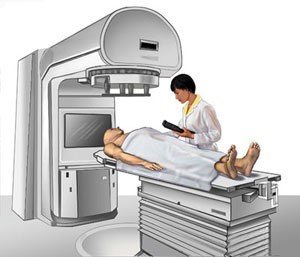Radiation Therapy
- Radiation therapy does not make patients radioactive.
Radiation therapy is a cancer treatment that uses focused beams of radiation to shrink or kill tumors.
This page talks about external beam radiation therapy. To learn more about internal radiation therapy, please visit the Nuclear Medicine page.
About Radiation Therapy
Source: National Cancer Institute (NCI)
Radiation therapy uses ionizing radiation to shrink or kill tumors. Focused beams of radiation are produced by a machine outside the body and are aimed at tumor cells inside the body, damaging cells and destroying their ability to divide.
During radiation therapy radiation beams target tumors but can also damage healthy cells. Before starting therapy, doctors carefully plan where to aim the radiation beam to damage the tumor as much as possible, while doing as little damage to healthy cells as possible.
Radiation therapy does not make the patient receiving the treatment radioactive. Like shining a flashlight at your skin, your skin is illuminated where the beam hits your skin. When you turn the flashlight off, your skin returns to its normal shade and is no longer illuminated.
There are many different types of radiation therapy that can be used to treat tumors. Some examples of radiation therapy include:
- Three-dimensional Conformal Radiation Therapy (3D-CRT): 3D-CRT is a type of radiation cancer treatment that uses special computers to get an accurate picture of the size, shape and location of the tumor. 3D-CRT can use single or multiple x-ray beams to target the tumor.
- Proton therapy: Proton therapy uses a beam of protons to target tumors. Unlike x-rays, which deposit energy along their path, protons deposit the majority of their energy at the end of their path. Doctors use proton therapy to minimize damage to healthy tissue while still targeting the tumor.
Radiation therapy can cause acute side effects, such as hair loss or nausea, which can occur during treatment. Most acute effects disappear after treatment. Because radiation damages cells, it can also increase the risk of cancer. There is a small chance that the cancer treatment itself will produce another cancer years later. Radiation therapy patients are screened frequently for cancer after successful treatment of their primary tumor.
Doctors and scientists continue to research radiation therapy methods to increase accuracy, decrease damage to healthy tissue, and reduce side effects to the patient.
What You Can Do
- Follow instructions given by their doctor or radiation therapist. Make sure to let the doctor and radiation therapist know if you are pregnant, might be pregnant, or are breastfeeding.

